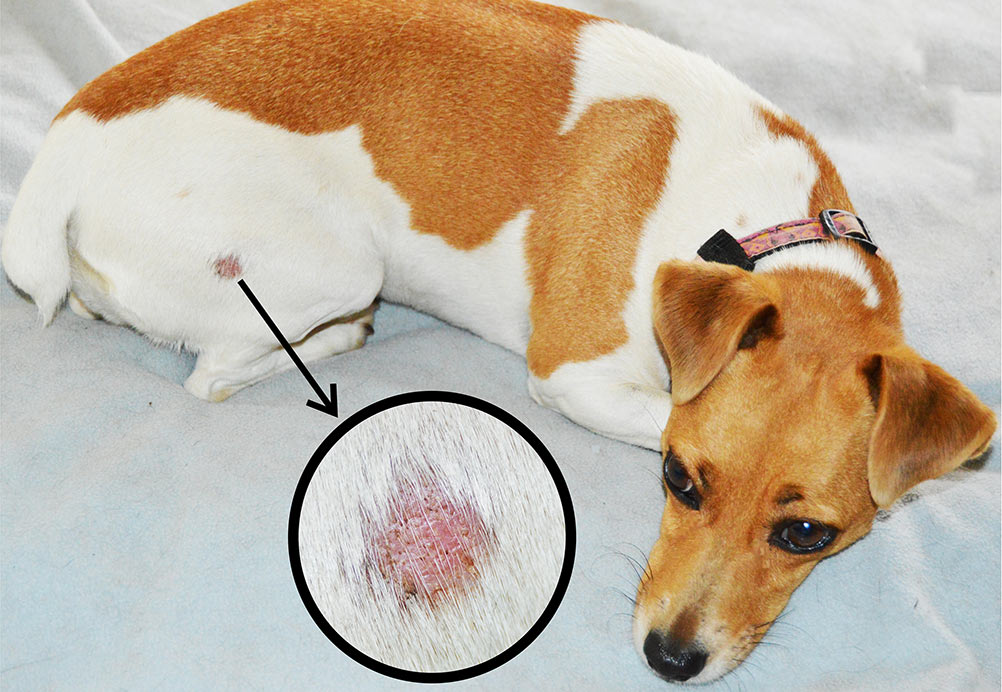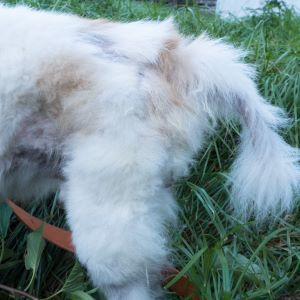Skin allergies in dogs and cats

Looking after a pet with a skin allergy can require a lot of time, effort and money, as well as being a big source of concern for you as an owner. Luckily, a lot of skin allergies which affect cats and dogs are quite manageable and treatable.
 There are many different types of skin allergies in pets, so it’s important to identify which one your pet is suffering so it can receive prompt and appropriate treatment.
There are many different types of skin allergies in pets, so it’s important to identify which one your pet is suffering so it can receive prompt and appropriate treatment.
Allergic dermatitis is an umbrella term used to describe any allergic reaction to food, grooming products or other irritants which cause an itchy red rash on the skin. Vets often prescribe corticosteroids to treat the rash, but the most effective treatment is to identify the allergen and remove it from your pet’s environment.
Cost of skin allergy treatment for dogs and cats
Skin allergies were one of the most common health issues experienced by dogs and cats in 2022, according to PetSure claims data. They were the most common health condition claimed for in dogs and most prevalent in dogs aged 1 to 8 years.
Claims data for skin allergies |
Average cost of treatment |
Highest cost of treatment |
| Dogs | $520 | $17,460 |
| Cats | $451 | $ 4,990 |
Because it is difficult to predict the costs of veterinary care, it can help to have measures in place to help prepare for the unexpected. Pet insurance can help by covering a portion of the eligible vet bill if the unexpected does happen.
Get a quote for 2 months free pet insurance in the first year.
The most common types of skin allergies in cats and dogs
These are fleas, food, and substances in the environment.
Fleas

If the irritant is fleas (or their saliva, as is usually the case), regular flea treatment and bathing is your best bet. For more serious cases, take your pet to the vet – they may prescribe an oral drug or topical treatment to assist clearing up the allergy. Be sure to give your pet regular preventative flea treatment.
Food
If food allergies are the culprit, aside from digestive issues, you may notice some foods cause red, itchy, irritated skin and eyes, inflamed ears and swollen paws. It’s important to see a vet if you suspect food allergies so your vet can perform a urinalysis and blood test to rule out any other potential causes. A food elimination diet may be prescribed to identify which food is causing the reaction. The cure is as simple as removing the irritating food from your pet’s diet.
Environment

Environmental allergy causes can be the hardest to identify and eliminate. The first question you should ask is if your pet’s allergy could be seasonal. If it’s spring, your pet could be affected by hayfever, for which the easiest treatment is a simple antihistamine (but be sure to consult your vet to get the right one). If someone in the household is a smoker, make sure they smoke well away from your pet. Cleaning products and air fresheners may also be responsible – fix this by removing air fresheners from your pet’s environment and keeping the house clean with natural cleaning products.
Preventing skin allergies in dogs and cats
Prevention is always better than cure, so be sure to implement the following tips and tricks to keep your pet safe and healthy:
- Keep your pet’s skin and coat clean and brush the coat regularly.
- Stay up to date with flea treatment.
- Examine the skin frequently to pick up any problems early.
- Feed a high quality diet.
- Avoid any known allergins or environments, such as particular types of grass.
- Check your cat for overgrooming, as this can be confused with skin disease or it may cause skin disease.
- Ask your vet to review your pet regularly and check for underlying diseases that could be affecting the skin and coat.
Are you sure it’s an allergic reaction?
Many pet owners may mistake something else for a skin allergy. Here are some common skin problems which may be the actual cause of your pet’s issues.

Yeast infection
If your cat or dog can be found scratching, chewing or licking itchy, discoloured skin around the paws or ears, they could be suffering a yeast infection. Fortunately, these are easy to identify and are treatable with ointment, oral drugs, or medicated baths.
Folliculitis
This is an infection which causes bumps and sores to appear on your pet’s skin. They’re quite easy to spot in short-haired breeds, but are harder to identify in longer-haired breeds – look out for shedding and scaly skin hidden under a dull coat. Often, folliculitis is a symptom of a larger issue such as mange, other allergies or even an injury. Antibiotics in the form of an oral medication, ointment or shampoo is often the best way to treat this condition.
Seborrhea dermatitis
Seborrhea is a skin condition that presents as flaky skin accompanied by a very bad odour. It destroys the sebaceous glands in the skin and they become inflamed and eventually destroyed. Symptoms usually first occur when the dog is from one to five years old. Typical symptoms include dry, scaly skin and hair loss on top of the head, neck, and back. Though this condition is cosmetic it can cause the dog great discomfort and it should be reviewed by a vet.
Dermoid Sinus
Dermoid Sinus is a skin condition in which a tube-shaped, cyst-like growth appears in the spinal area. It can protrude from the skin and possibly enter into the muscle tissue. If it becomes infected, the condition can become more serious. Some affected dogs have corrective surgery while some are euthanised.
Demodectic mange

Demodex mites are passed down from mother to pup but are not transferrable to other dogs or humans. These mites are normal and present in every dog, and typically do not cause any issues. However, a dog with a weak immune system could develop demodectic mange. Characterised by red, scaly skin and hair loss, the disease often goes away on its own, but should still be discussed with a vet.
For more details about mange, click here.
Ichthyosis
Ichthyosis is an inherited skin disease causing thickened skin and painful, swollen food pads. It is a painful, itchy and uncomfortable condition for which there is no cure. Treatment often includes frequent medicated baths and ointment.
Ringworm

Ringworm (also known as dermatophytosis) is the one of the most common fungal skin infection that affects cats and dogs. It is a parasite that invades the dead outer layers of the skin which includes paws and fur. Long-haired breeds are more susceptible to ringworm than short-haired breeds. Ringworms can be passed from pets to humans and vice versa. Ringworm appears as round patches of rough, scaly skin with a red outline and bald patches may be present.










